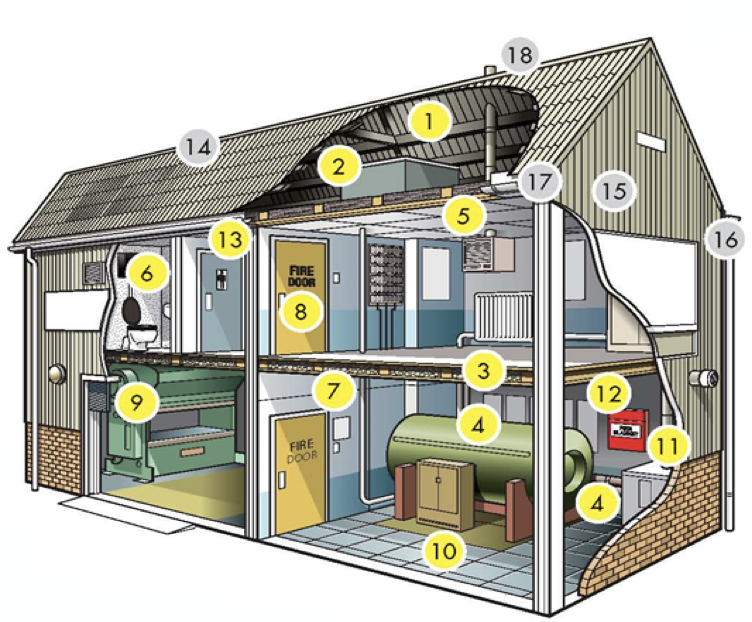
Why Is Asbestos Dangerous? A Global Look at Its History and Use Across Countries
Asbestos is dangerous because it is composed of microscopic fibers that can become airborne when disturbed. When inhaled or ingested, these fibers can cause severe, long-term health issues. The body has difficulty expelling asbestos fibers, which can lodge in tissues and lead to inflammation, scarring, and, eventually, life-threatening diseases. Asbestos was widely used globally during the 19th and 20th centuries.
SAFETY
3 min read

Primary Health Risks
Asbestosis
What it is: A chronic lung disease caused by the inhalation of asbestos fibers, leading to scarring (fibrosis) of lung tissue.
Symptoms: Shortness of breath, persistent cough, and chest pain.
Impact: The condition progressively worsens, impairing lung function and often leading to respiratory failure.
Mesothelioma
What it is: A rare and aggressive cancer affecting the thin layer of tissue covering the lungs (pleura) or abdomen (peritoneum).
Latency period: Can take 20-50 years to develop after asbestos exposure.
Prognosis: Usually poor, with limited treatment options.
Lung Cancer
Link to asbestos: Smokers exposed to asbestos face a significantly higher risk of developing lung cancer.
Symptoms: Persistent cough, chest pain, weight loss, and difficulty breathing.
Other Cancers
Asbestos exposure is also associated with cancers of the larynx, ovaries, and gastrointestinal tract.
Pleural Plaques and Effusions
Non-cancerous thickening or calcification of the pleura (lining of the lungs), often a marker of asbestos exposure.
Why It’s So Dangerous
Microscopic Fibers: Asbestos fibers are incredibly fine, often 1,200 times thinner than a human hair, making them easy to inhale or ingest without noticing.
Durability: Asbestos does not break down inside the body, so fibers can remain in tissues for decades.
Latency Period: Diseases linked to asbestos exposure often develop many years (20–50) after initial exposure, delaying diagnosis and intervention.
Irreversible Damage: Once inhaled, fibers can cause ongoing damage, including inflammation and genetic changes in cells that may lead to cancer.
How Exposure Happens
Occupational: Common in industries like construction, shipbuilding, mining, and manufacturing, especially before the 1980s.
Environmental: Living near asbestos mines or naturally occurring deposits.
Secondary: Family members of workers exposed to asbestos dust brought home on clothing.
Renovation or Demolition: Disturbing old asbestos-containing materials like insulation, roofing, or flooring.
Modern Safety Measures
Bans and Regulations: Most developed countries have banned or restricted asbestos use.
Asbestos Abatement: Specially trained professionals safely remove asbestos from buildings.
Protective Equipment: Workers in high-risk jobs use respirators and protective clothing.
Even brief exposure to asbestos can pose significant health risks, making it one of the most dangerous industrial materials ever used. Its long latency period and potential to cause fatal diseases underscore the importance of avoiding exposure and properly managing existing asbestos materials.


Below is a breakdown by regions and their historical timelines for asbestos usage:
Europe
United Kingdom: Asbestos was heavily used from the late 19th century, peaking between the 1950s and 1970s. Its use in construction and manufacturing was banned in 1999.
Germany, France, and Italy: Industrial use surged post-WWII for insulation, roofing, and shipbuilding. Bans were implemented in the 1990s (Germany in 1993, France in 1997, and Italy in 1992).
Eastern Europe: Some countries used asbestos into the early 2000s due to slower regulatory changes.
Russia: One of the largest producers of asbestos, with extensive use in construction and industry continuing today.
United States and Canada
United States: Asbestos was widely used from the late 19th century, peaking in the 1940s-70s for construction, automotive, and shipbuilding. Bans began in the 1970s, but some uses are still allowed under strict regulations.
Canada: Canada was a major producer and user, especially in the construction industry, from the late 19th century until a full ban in 2018.
Asia
Japan: Heavily used in construction and industry from the 1950s to 1980s. Phased bans were introduced starting in 1995, with a complete ban in 2012.
India and China: Asbestos is still used in some regions, especially in roofing and insulation. Both countries have not completely banned it but have regulations for safety.
Australia and New Zealand
Australia: Used heavily from the 1940s to the 1980s in construction and manufacturing. A full ban was implemented in 2003.
New Zealand: Used in construction and industry until the 1980s, with a full ban in 2016.
South America
Brazil: A leading producer and user of asbestos until it banned the material in 2017.
Argentina and Chile: Both banned asbestos in the early 2000s after decades of use.
Africa
South Africa: A major producer of asbestos (e.g., crocidolite or blue asbestos) until it banned the material in 2008.
General Timeline
1800s: Asbestos gained popularity during the Industrial Revolution for its insulating properties.
1900-1970s: Peak global use, especially in construction, shipbuilding, automotive, and textiles.
1980s-1990s: Countries began restricting and banning asbestos after links to mesothelioma, asbestosis, and lung cancer were proven.
2000s-Present: Most developed nations have banned asbestos, but its use persists in some developing countries due to cost and industrial reliance.
These are places you can find asbestos.

